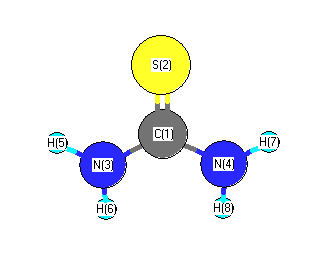Vibrational Frequencies calculated at B3LYP/cc-pV(T+d)Z
| Mode Number |
Symmetry |
Frequency
(cm-1) |
Scaled Frequency
(cm-1) |
IR Intensities
(km mol-1) |
Raman Act
(Å4/u) |
Dep P |
Dep U |
|---|
| 1 |
A |
3692 |
3564 |
19.37 |
|
|
|
| 2 |
A |
3565 |
3441 |
9.96 |
|
|
|
| 3 |
A |
1652 |
1595 |
69.06 |
|
|
|
| 4 |
A |
1411 |
1362 |
266.67 |
|
|
|
| 5 |
A |
1066 |
1029 |
65.23 |
|
|
|
| 6 |
A |
768 |
741 |
10.02 |
|
|
|
| 7 |
A |
501 |
484 |
29.15 |
|
|
|
| 8 |
A |
459 |
443 |
6.21 |
|
|
|
| 9 |
A |
346 |
334 |
124.48 |
|
|
|
| 10 |
B |
3691 |
3563 |
62.18 |
|
|
|
| 11 |
B |
3557 |
3434 |
41.99 |
|
|
|
| 12 |
B |
1627 |
1571 |
206.04 |
|
|
|
| 13 |
B |
1426 |
1376 |
94.32 |
|
|
|
| 14 |
B |
1071 |
1034 |
19.57 |
|
|
|
| 15 |
B |
643 |
620 |
9.01 |
|
|
|
| 16 |
B |
587 |
566 |
82.45 |
|
|
|
| 17 |
B |
400 |
386 |
3.46 |
|
|
|
| 18 |
B |
388 |
374 |
306.39 |
|
|
|
Unscaled Zero Point Vibrational Energy (zpe) 13423.1 cm
-1
Scaled (by 0.9654) Zero Point Vibrational Energy (zpe) 12958.7 cm
-1
See section
III.C.1 List or set vibrational scaling factors
to change the scale factors used here.
See section
III.C.2
Calculate a vibrational scaling factor for a given set of molecules
to determine the least squares best scaling factor.
Charges, Dipole, Quadrupole and Polarizability
Charges from optimized geometry at B3LYP/cc-pV(T+d)Z
Charges (e)
| Number |
Element |
Mulliken |
CHELPG |
AIM |
ESP |
| 1 |
C |
0.175 |
|
|
|
| 2 |
S |
-0.374 |
|
|
|
| 3 |
N |
-0.216 |
|
|
|
| 4 |
N |
-0.216 |
|
|
|
| 5 |
H |
0.173 |
|
|
|
| 6 |
H |
0.143 |
|
|
|
| 7 |
H |
0.173 |
|
|
|
| 8 |
H |
0.143 |
|
|
|
Electric dipole moments
Electric dipole components in Debye
(What's a Debye? See section
VII.A.3)
| |
x |
y |
z |
Total |
| |
0.000 |
0.000 |
-4.971 |
4.971 |
| CHELPG |
|
|
|
|
| AIM |
|
|
|
|
| ESP |
|
|
|
|
Electric Quadrupole moment
Quadrupole components in D Å
| Primitive |
|---|
| | x | y | z |
|---|
| x |
-34.107 |
2.241 |
0.000 |
| y |
2.241 |
-25.909 |
0.000 |
| z |
0.000 |
0.000 |
-29.102 |
|
| Traceless |
|---|
| | x | y | z |
|---|
| x |
-6.601 |
2.241 |
0.000 |
| y |
2.241 |
5.695 |
0.000 |
| z |
0.000 |
0.000 |
0.906 |
|
| Polar |
|---|
| 3z2-r2 | 1.812 |
|---|
| x2-y2 | -8.197 |
|---|
| xy | 2.241 |
|---|
| xz | 0.000 |
|---|
| yz | 0.000 |
|---|
|
Polarizabilities
Components of the polarizability tensor.
Units are
Å
3 (Angstrom cubed)
Change units.
| |
x |
y |
z |
| x |
4.181 |
0.175 |
0.000 |
| y |
0.175 |
7.209 |
0.000 |
| z |
0.000 |
0.000 |
9.953 |
<r2> (average value of r
2) Å
2
| <r2> |
101.500 |
| (<r2>)1/2 |
10.075 |
